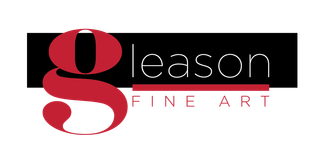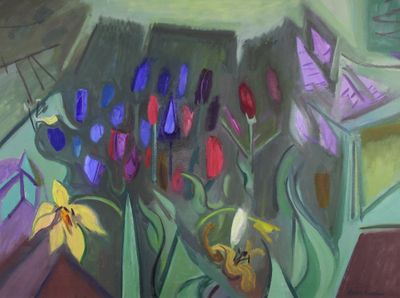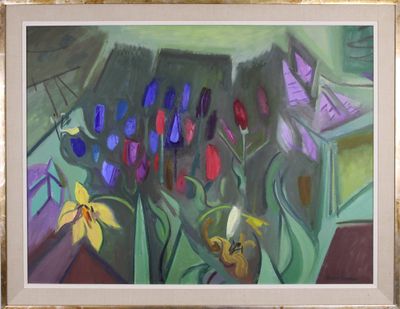Maurice Freedman
Maurice Freedman was a prolific painter who worked quietly from his early years in Boston in the 1920s until his death in 1985. Freedman's body of work belongs to the cubist-inspired American Modernist movement. American Modernism is defined as being born at the New York Armory Show* of 1913, where the works of Picasso, Braque, Duchamp, and Rodin were shown in the US for the first time, along with work by their American counterparts.
Maurice Freedman was a prolific painter who worked quietly from his early years in Boston in the 1920s until his death in 1985. Freedman's body of work belongs to the cubist-inspired American Modernist movement. American Modernism is defined as being born at the New York Armory Show* of 1913, where the works of Picasso, Braque, Duchamp, and Rodin were shown in the US for the first time, along with work by their American counterparts.
Realistically, its roots go back to the turn of the century, when John Sloane's Ashcan School* sought to depict the underbelly of American urban life instead of the bourgeois reveries of Impressionism*.
Photographer and curator Alfred Stieglitz and the art critic Sadakichi Hartmann helped define and shape the world's first international style into a unique American movement that established New York as a significant art center. In the teens, Marsden Hartley, Charles Demuth, John Marin, and Joseph Stella redefined Cubism, with its sedate academic roots, giving it a raw American exuberance. At the end of the World War I, German expressionism, with a similar energy, rose to prominence in Europe. These forces combined to deeply influence the direction of art students, chafing under the academic restrictions of the time, especially in a city like Boston.
Freedman was the second of five children, born in Boston's Dorchester neighborhood where his father was a butcher. Expected to seek out a more traditional livelihood, like the rest of his extended family, he discovered his artistic talent at an early age. His family recalled that at the age of four, he was drawing with a bar of Bon Ami soap on a slate sink. During his teens, he traveled New England during the summers as a trumpet player in a jazz band called the Teddy Bears, playing in casinos along the coast of Maine. Freedman studied at both the School of the Museum of Fine Arts, and what has become the Massachusetts College of Art. His friends in school included John Whorf, who made his reputation as a Cape Cod artist and teacher, and fellow painter Henry "Harry" Botkin, a nephew of the Gershwin brothers.
Following Botkin, Freedman left Boston for New York and Paris, both tantalizing magnets to artists intent on helping define the energy of the "Roaring Twenties." In Manhattan, he attended classes at the Art Students League*, then the most innovative art school in the US, and also worked as an art director for the Pathé Movie Exchange.
In Paris, he studied with André Lhôte, where he learned to synthesize his traditional academic training with the European trends of Cubism* and Expressionism*, then considered avante-garde. Critic John Russell observed in a review of Freedman's work in 1982 that Freedman "had learned to draw with a loaded brush, how to handle rich and strong color without letting it get out of hand, and how to give individuality to everyday objects." It was during his second sojourn in Paris in 1930 that he first saw Max Beckmann's psychologically-charged work.
Upon his return to New York, in the doldrums of the Great Depression, Freedman resumed art directing, which provided a steady income that enabled him to continue painting. He gained representation with Midtown Galleries, who handled his work from 1934 until his death. During this time he made painting trips to New Mexico, to Maine, and to Cape Cod, and developed close friendships with Marsden Hartley, John Marin, and Milton Avery, the leading American painters of the previous generation.
In 1938, he met his future wife Louise Arnstein, a painter-printmaker, and an early experimenter in monotype*. She was a Vassar graduate from a well-to-do St. Louis family who wrote poetry and taught printmaking into her later years. Their younger son Alan observes, "They were both different people before they had kids, yet shared a deep love for art and each other."
Too old for the draft at the beginning of WWII, Freedman designed camouflage* and worked with Army intelligence as his contributions to the war effort. He continued to art direct for RCA, and later for the Columbia movie houses. He designed marquees and posters and had a talent for capturing the mood of any picture he was charged with promoting. As Alan Freedman remembers, "He was very facile—he could draw anything." During this time, Freedman also met some of the great movie stars of the era: Douglas Fairbanks, Errol Flynn, and Humphrey Bogart, as well as Kim Novak, Rita Hayworth, and Lana Turner.
The German Expressionist Max Beckmann arrived in New York in the late 1940s from St. Louis where he had been lecturing at Washington University. It was during this time that Freedman became friends with the older artist through his brother-in-law, St. Louis department store heir and collector Morton May. "It was my father who first encouraged Morton May to purchase Beckmann's work," says Alan Freedman. Eventually, this collection became the largest of the German-born artist's in the United States. May was also a lifelong patron of Freedman's work. His sons observe that "Morton May had an extreme fondness for both our folks." Until his death in 1983, May sponsored and collected Freedman's work, telling him "to paint what you want."
By the early '50s, the Freedmans had left Manhattan with their two sons, Joel and Alan, for Hastings-on-Hudson. Up early to make the morning commute into the city, Freedman would return home, eat supper, and then go upstairs to his studio. As Alan recalls, his father "had to use his free time to paint: he used any chance to go to his studio and paint, even into the late nights."
Alan remembers that his father smoked a pipe: "Besides tobacco, his pockets carried pencils, charcoal sticks, and small pieces of paper." He constantly made small sketches, translating what he saw into studies which might become paintings.
From occasional painting trips to the Cape, beginning in the 1930s, Maurice Freedman rented houses in Wellfleet and Truro, as well as Provincetown, throughout his lifetime. The Freedmans alternated trips to Maine and Europe with the Cape. In the early '50s, they stayed in a house on Mayflower Heights overlooking Cape Cod Bay. Here, they weathered hurricanes Carol and Connie. Maurice painted in the garage which he converted into a makeshift studio. As the light changed during the day, he would use the garage doors as light baffles. Usually, he would stop working in the late afternoon, perhaps going for a swim or a beach picnic.
The late '50s brought them to the East End of Provincetown, where they rented the Hapgood house on Allerton Street, and then painter Maurice Sterne's house, "Levitation," on the harbor. An advantage of the Sterne house was its second floor studio, jutting out from the main house with windows on three sides, which allowed Freedman consistent light throughout the day, as well as a high vantage point from which to observe the waterfront. Alan Freedman recalls that his father "loved the light, loved the landscape: that's why he painted."
Maurice Freedman might work on several paintings at once. Though he painted fast, occasionally one canvas might be set aside in order to figure out how to resolve it later. One of Alan's strongest memories was "waking up to the sloshing of brushes and the smell of turpentine in the studio. On hearing me outside the door, he would ask, 'Al, help me wrestle with this canvas,' since he stretched his supports using tacks instead of staples to hold the fabric on the stretcher bars."
In the rampant social scene of the '50s, Freedman socialized little. As artist and art historian Tony Vevers recalls, Maurice was "kind of a reticent person." Curator Walter Barker, who organized Freedman's retrospective at Washington University in St. Louis in 1972, concurred, calling him "a quiet giant." His son Alan recalls, "He stuck to his guns and used his time wisely, not always having to be at every social event." In Provincetown and Wellfleet, the Freedmans were friends with Sol and Dora Wilson, Edna and Bernard Simon, Boris Margo, Lewis and Erica Rubenstein, Joe and Virginia Kaplan, Irving and Evelyn Marantz, and Gerrit and Paula Hondius.
As Alan Freedman observed,"Dad picked his friends." What close friends they were. He knew Milton Avery and had special ties to Karl Knaths. The Freedmans shared similar inspirations as these artists did within the Modernist movement, as well as similar ways of expressing it. Milton and Sally Avery imbued their abstracted paintings of the Cape with a sense of geographic specificity, while Karl Knaths brought a deliberate simplification of form, combined with defined calligraphic strokes, serving as both symbols and objects, to unify his paintings.
His wife, Helen Weinrich Knaths, sister of the better-known Agnes, used color as flattened planes in her work, which became increasingly abstract. Freedman's wife Louise made abstracted silkscreen prints of the American landscape. Maurice's paintings combined brilliant colors and simplification of forms that evoked the symbolism found in the work of his friends Marsden Hartley and Max Beckmann. One thing apparent within this particular circle of friends is that their work was exuberant and passionate.
Freedman's work is frequently lyrical, and aspects of his paintings present themselves only after considered observation, such as a black cat sitting sphinx-like in the darkened corner of a still-life, or the catalog from his '72 retrospective lying on a table top in the painting "Wellfleet Studio." The viewer's eye travels throughout these compositions, where color, outline, and form intersect to carom the movement elsewhere in the painting.
In his "Quatro" self-portrait, dating from 1970, we see his likeness repeated within the reflections of a tailor's mirror. Echoing the multiplicity of viewpoints expressed in cubism, we see the many facets of a complicated personality. As Freedman revealed to his son Joel in a documentary about his work, "Things usually evolve as painters work: things happen, certain paths open up which artists take advantage of. A kind of spirit of curiosity follows through various color suggestions and divine directions to become a more inspiring performance."
At the end of their time at the Cape, Maurice would load the car-top carriers with finished canvases, paintings that were in-process and still wet, and canvases onto which the under drawing had been limned in charcoal. Pinned with large nails at the corners and wrapped in oil cloth, this work would return to the studio in Hastings-on-Hudson.
The frenetic pace at which Maurice Freedman worked eventually took its toll and he died at the age of 80 in 1985. Alan says, "My Dad just wore himself out. He stuffed enough living into those 80 years that it seemed he was in his 90s." Freedman, like his friend the author Thomas Wolfe, had to leave the confines of his hometown and extended family in order to make his mark on the world. The paintings he left behind document this quest for creative wholeness.
MAURICE FREEDMAN was feted with three major shows in 2004, the one hundredth anniversary year of his birth. In July, Greenhut Gallery in Portland, Maine, showed his paintings of the Downeast coast, and in August, the Julie Heller Gallery in Provincetown and the Cape Cod Museum of Art in Dennis showcased his work. The Cape Museum centennial retrospective was curated by Mary Sherman.


